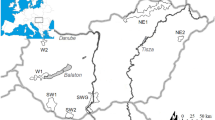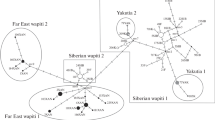Abstract
The present study investigates the genetic structure of 12 roe deerCapreolus capreolus Linnaeus, 1758 population samples from Serbia, by screening a total of 334 individuals. We examined whether genetic differentiation exists in local populations in Serbia, and addressed the question whether management policies may affect genetic structure. The populations were analysed by multilocus protein electrophoresis, with 33 protein loci examined. Screening of 20 enzymes and one group of general proteins revealed polymorphism at the following 12 loci: Sdh, Mdh-1, Me-1, Idh-2, 6-Pgd-1,αGpd, Ak, Pgm-1, Pgm-2, Ca, Mpi andGpi. Among samples, the proportion of polymorphic loci varied between 3–15.2% (mean 11.9%), while the average gene diversity was in the range of 1.1–4.2%. The overall genetic differentiation was low (θ = 0.03). The comparison of two regional population groups (northern-southern, separated by the Danube River) showed an absence of genetic differentiation between regions. Gene flow was estimated at 8.96 migrants per generation, and was higher in the lowland than in the highland group. Three loci (Ca, 6-Pgd andGpd-1) showed clinal variation along a geographical gradient. Additional five alleles of four loci (Ak, Pgm-1, Gpi, 6-Pgd) showed significant spatial autocorrelation. Genetic distances were small (D = 0–0.004). Northern and southern populations clustered separately. For at least three populations game management practices provide evidence for outlying genetic parameters. The observed heterogeneity in the inbreeding level was deemed more under the influence of non-random mating strengthened by game management, than by overall selective pressure.
Similar content being viewed by others
References
Archie J. W. 1985. Statistical analysis of heterozygosity data: independent sample comparisons. Evolution 39: 623–637.
Ayala F., Powell J. R., Tracey M. L., Mourao C. A. and Parez-Salas S. 1972. Enzyme variability in theDrosophila willistoni group. IV. Genetic variation in natural populations ofDrosophila willistoni. Genetics 70: 113–139.
Baccus R., Ryman N., Smith M. H., Reuterwall C. and Cameron D. 1983. Genetic variability and differentiation of large grazing mammals. Journal of Mammalogy 64: 109–120.
Chapuisat M., Goudet J. and Keller L. 1997. Microsatellites reveal high population viscosity and limited dispersal in the antFormica paralugubris. Evolution 51: 475–482.
Ernhaft J. 1995. Populationgenetishe Untersuchungen an der Wildtiern für die Vorberitung der Genkonservation. Vadbiológia 4: 48–53.
Ernhaft J. 1996. Comparative population-genetical studies in four deer populations in Hungary. Vadbiológia 5: 24–28.
Fakler P. and Schreiber A. 1997. Allozyme heterozygosity in two isolated populations of roe deer (Capreolus capreolus) in the Netherlands. Netherlands Journal of Zoology 47: 1–8.
Felsenstein J. 2004. PHYLIP (Phylogeny Inference Package) version 3.6. Distributed by the author. Department of Genome Sciences, University of Washington, Seattle.
Gonzales-Candelas F., Crnobrnja J., Kalezić L. M. and Moya A. 1992. Gene flow rates in Yugoslavia populations of the smooth newtTriturus vulgaris. Journal of Evolutionary Biolology 5: 481–490.
Goudet J. 2001. FSTAT, a program to estimate and test gene diversities and fixation indices (version 2.9.3). Available from http://www.unil.ch/izea/softwares/fstat.html.
Hamilton W. D. 1971. Selection of selfish and altruistic behaviour in some extreme models. [In: Man and beast: Comparative social behavior. J. F. Eisenberg and W. S. Dillon, eds] Smithsonian Inst. Press, Wash, DC: 57–91.
Hartl G. B. and Reimoser F. 1988. Biochemical variation in roe deer (Capreolus capreolus L.): Arer-strategists among deer genetically less variable than K-strategists? Heredity 60: 221 - 227.
Hartl G. B., Reimoser F., Willing R. and Koller J. 1991. Genetic variability and differentiation in the roe deer (Capreolus capreolus L.) of Central Europe. Génétique Sélection Évolution 23: 281 - 299.
Hartl G. B., Markov G., Rubin A., Findo S., Lang G. and Willing R. 1993. Allozyme diversity within and among populations of three ungulate species (Cervus elaphus, Capreolus capreolus, Sus scrofa) of Southeastern and Central Europe. Zeitschrift für Säugtierkunde 58: 352–361.
Hartl G. B., Hewison M. A. J., Apollonio M., Kurt F. and Wiehler J. 1998. Genetics of European roe deer. [In: The European roe deer: The biology of success. R. Andersen, P. Duncan and J. D. C. Linnell, eds]. Scandinavian University Press, Oslo: 71–90.
Hewison A. J. M. 1995. Isozyme variation in roe deer in relation to their population history in Britain. Journal of Zoology, London 235: 279–288.
Kurt F., Hartl G. B. and Volk F. 1993. Breeding strategies and genetic variation in European roe deerCapreolus capreolus populations. Acta Theriologica 38, Suppl. 2: 187–194.
Levene H. 1949. On a matching problem arising in genetics. Annual Mathematics and Statistics 20: 91–94.
Lorenzini R., Patalano M., Apollonio M. and Mazzarone V. 1993. Genetic variability of roe deer (Capreolus capreolus) in Italy: electrophoretic survey on populations of different origin. Acta Theriologica 38, Suppl. 2: 141–151.
Lorenzini R., Matiolli L., Rustioni M. and Patalano M. 1996. Allozyme and craniometric variability in the Roe deer (Capreolus capreolus L.) from Central Italy. Zeitschrift für Säugetierkunde 61: 7–24.
Lorenzini R., Burrini L., Mazzoni della Stella R. 1997. Biochemical genetic differentiation in some roe deer populations of Tuscany, central Italy. Italian Journal of Zoology 64: 239–244.
Markov G. G. and Chassovnikarova T. 1998. Genetic variability of the roe deer (Capreolus capreolus L.) in Bulgaria — RFLP analysis of the mtDNA. Dokladi na Blgarska Akademia na Naukite 51(7–8): 91–93.
Milošević-Zlatanović S. 2001. [Zoogeographical and population differentiation on the roe deer (Capreolus capreolus L.) from Yugoslavia]. PhD thesis, University of Belgrade: 1–205. [In Serbian]
Milošević-Zlatanović S., Savić R. I. and Stamenković S. 1994. Genetic divergence in the roe deer (Capreolus capreolus L.) in Yugoslavia. Bios 2: 307–314.
Milošević-Zlatanović S., Crnobrnja-Isailović J., Savić R. I. and Stamenković S. 1997. Genetic variability of roe deer populations (Capreolus capreolus L.) from northeast Yugoslavia. Zeitschrift für Säugetierkunde 62: 339–349.
Milošević-Zlatanović S., Ćeranić A. and Stamenković S. 2003. Ecogeographic constraints in current game management of the roe deer (Capreolus capreolus L.) in Serbia. XXVI. International Congres of IUGB, Braga, Portugal, Abstracts: 72.
Nei M. 1978. Estimation of average heterozygosity and genetic distance from a small number of individuals. Genetics 89: 583–590.
Pamilo P. 1984. Genotypic correlation and regression in social groups: multiple alleles, multiple loci and subdivided populations. Genetics 107: 307–320.
Pamilo P. 1985. Effect of inbreeding on genetic relatedness. Hereditas 103: 195–200.
Queller D. C. and Goodnight K. F. 1989. Estimating relatedness using genetic markers. Evolution 42: 258–275.
Randi E., Alves P. C., Carranza J., Miloševic-Zlatanović S., Sfougaris A. and Mucci N. 2004. Phylogeography of roe deer (Capreolus capreolus) populations: the effects of hystorical genetic subdivisions and recent nonequilibrium dynamics. Molecular Ecology 13: 3071–3083.
Rohlf F. J. 1998. NTSYS pc 2.02, user guide. Exeter software, New York.
Ryman N., Beckman G., Bruun-Petersen G. and Reuterwall C. 1977. Variability of red cell enzymes and genetic implications of management policies in Scandinavian moose (Alces alces). Hereditas 85: 157–162.
Ryman N., Baccus R., Reuterwall C. and Smith M. H. 1980. Effective population size generation interval and potential loss of genetic variability in game species under different hunting regimes. Oikos 36: 257–266.
Schreiber A., Kolter L. and Kaumanns W. 1993. Conserving patterns of genetic diversity in endangered mammals by captive breeding. Acta Theriologica 38, Suppl. 2: 71–88.
Simon C. and Archie J. 1985. An empirical demonstration of the lability of heterozygosity estimates. Evolution 39: 463–467.
Smith H. M., Branan W. V., Marchinton R. L., Johns P. E. and Wooten M. C. 1986. Genetic and morphologic comparisons of red brocket, brown brocket and white-tailed deer. Journal of Mammalogy 67: 103–111.
Sneath P. H. and Sokal R. R. 1973. Numerical Taxonomy: the principles and practice of numerical classification. San Francisco: Freeman and Co.: 1–573.
Sokal R. R. and Oden N. L. 1978a. Spatial autocorrelation in biology. I. Methodology. Biological Journal of Linnean Society 10: 199–228.
Sokal R. R. and Oden N. L. 1978b. Spatial autocorrelation in biology. II. Some biological implications and four applications of evolutionary and ecological interest. Biological Journal of Linnean Society 10: 229–249.
Sokolov V. E., Shurkal V., Danilikin A. A., Podogas A. V., Rakitskaya T. A. and Markov G. 1986. [A comaprative analysis of electrophoretic spectra of blood and muscle-tissue proteins of European (Capreolus capreolus L.) and Siberian (Capreolus pyrargus Pall.) roe deer]. Proceedings of Academy of Sciences USSR (Biological Sciences) 288: 391–393. [In Russian]
Swofford D. L. and Selander R. B. 1981. Biosys 1. A Fortran program for the comprehensive analysis of electrophoretic data in population genetics and systematics. Journal of Heredity 72: 281–283.
Šelmić V. 2001. [A program for hunting development in Serbia 2001–2010]. Hunting association of Serbia, Belgrade: 1–241. [In Serbian]
Wang M. and Schreiber A. 2001. The impact of habitat fragmentation and social structure on the population genetics of roe deer (Capreolus capreolus L.) in Central Europe. Heredity 86: 703–715.
Wartenberg D. 1989. SAAP. Version 4.3. Manual. Piscataway, NJ.
Wehner von J., Muller H. P. and Kierdorf H. 1991. Investigation of the genetic situation of select Rhineland deer populations with special consideration of changes due to isolation. Zeitschrift fur Jagdwissenschaft 37: 40–48.
Weir B. S. and Cockerham C. C. 1984. EstimatingF-statistics for the analysis of population structure. Evolution 38: 1358–1370.
Wiehler J. and Tiedemann R. 1998. Phylogeography of the European roe deerCapreolus capreolus as revealed by sequence analysis of the mitochondrial control region. Acta Theriologica, Suppl. 5: 187–197.
Wright S. 1978. Evolution and genetics of populations. Vol. 4. Variability within and among natural populations. Univ. Chicago Press, Chicago, Illinois: 1–580.
Author information
Authors and Affiliations
Additional information
Associate Editor was Krzysztof Schmidt.
Rights and permissions
About this article
Cite this article
Milošević-Zlatanović, S., Crnobrnja-Isailović, J. & Stamenković, S. Allozyme variability and differentiation in Serbian roe deer populationsCapreolus capreolus . Acta Theriol 50, 429–444 (2005). https://doi.org/10.1007/BF03192637
Received:
Accepted:
Issue Date:
DOI: https://doi.org/10.1007/BF03192637




